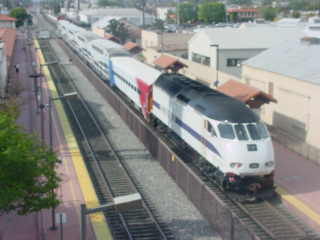
The Comet railcar is a class of locomotive-hauled railcars that was first designed in the late 1960's by Pullman-Standard as a modern commuter car for North American rail lines. Later, the Comet moniker was adopted by New Jersey Transit for all of its non-powered single level commuter coaches. Additional series of cars bearing the Comet name, based on the original design, have since been built by Bombardier Transportation and Alstom. The successful design was adopted by numerous commuter agencies.
Comet IThese cars were the first of the Comet series, built by Pullman Standard in 1970–73 for the New Jersey Department of Transportation and used the Erie-Lackawanna Railroad's diesel-hauled commuter services. These railcars were named after the Jersey Central train Blue Comet. These were considered state-of-the-art at the time, due to their all-aluminum body shell construction as well as their use of head-end power (HEP). Their automated entrance doors, designed for use with low platforms only, earned them the nickname "Sliders". 155 cars were built, with 35 cab cars, 110 trailer coaches and 10 bar cars.
In 1987, the fleet was rebuilt by Bombardier at Barre, Vermont, with all 35 cab cars and a number of trailer cars receiving high doors, for ADA access and future compatibility with high platforms. They were given NJ Transit logos adjacent to the entrance doors at this time, as NJ Transit had taken over EL commuter service. The bar cars were converted to standard coaches.
The low door cars were retired from service in 2005. 25 of the cars were sold to Utah Transit Authority for the FrontRunner service and 20 were leased to Metrolink in 2008 to help with an acute car shortage there. In March 2011, Metrolink returned the cars to FrontRunner upon the expiration of the lease. Metrolink also leased 15 cars directly from New Jersey Transit in 2009. These cars have not been used since 2011. The Comet I cars have become popular with western commuter lines as the low door setup is compatible with the low-platform stations in use. Eight Comet I's were sold to SEPTA, but are now out of service and put into storage. Some of these have recently been used in work service.
My TripAfter work I went home to get my camera and drove to the Santa Ana station as I had an Amtrak ticket to Irvine which I needed to use for the Triple Guest Rewards points. As Pacific Surfliner 578 arrived, Amtrak CEO Joseph Boardman detrained and I said hello to him before boarding for the nine-minute trip to Irvine. There I bought my Metrolink tickets and went out to the platform to wait, learning that the train was running late from the electronic message board. Later I saw a headlight and something did not look like normal when the train came into view but once I saw what was different, I was extremely happy.

Metrolink 684 arrived twenty minutes late with a Comet Car in its consist.

Utah Transit Authority Comet Car 315 which I boarded for my trip to Laguna Niguel then home to Santa Ana.
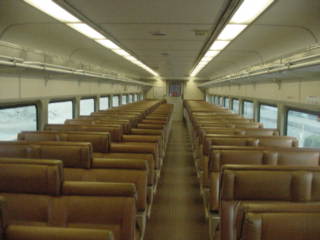
Looking from the A end to the B end of this car.
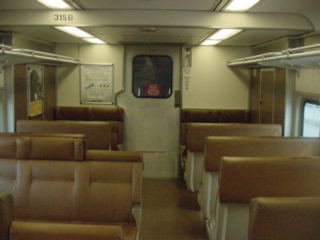
The B end of Comet Car 315.

Looking from the B end towards the A end.

The A end.

The door closed and passengers could not be in the vestibule while the train was in motion.

The car's builder's plate.
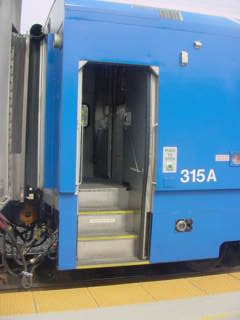
Both doors open at all station stops.
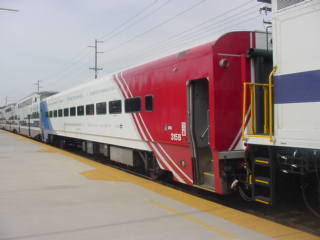
Another view of Comet Car 315.
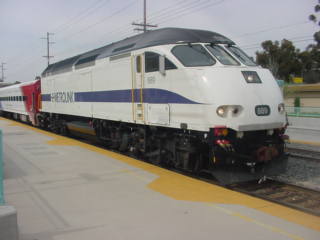
One of Metrolink's newest locomotives, MP36PH-3C 899 built by Motive Power Industries built in 2008.

Metrolink 684 at Laguna Niguel.

The Utah Transit Authority emblem.
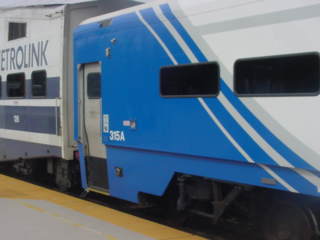
The doors were now closed as the train prepared to leave Laguna Niguel.

Metrolink 684 departed for CP Avery where it would switch tracks and returne to Laguna Niguel as Metrolink 804.

Metrolink 804 came back into the Laguna Niguel/Mission Viejo station.


Utah Transit Authority Comet coach 315.

The Front Runner name on the car.

The Utah Transit Authority lettering. I boarded the Comet Car for the trip back to Santa Ana and it was interesting to see the Metrolink riders' faces when they boarded at Irvine and Tustin.
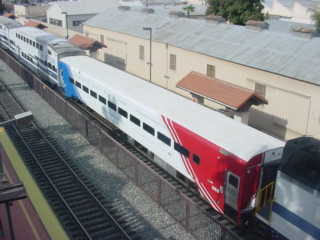
After detraining, I went up on the bridge at Santa Ana where I set up for a picture of the train and the Comet Car from above.

Metrolink 804 leaves Santa Ana on its way to San Bernardino. I went home to write this story before going to the Orange County Railway Historical Society meeting where these pictures were shown.
| RETURN TO THE MAIN PAGE |